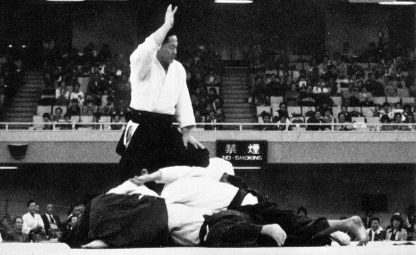
PRACTICE OF THE DAITO-RYU AIKIBUDO
Those who practice the Daito-ryu Aikibudo must
learn the Aikijujutsu which is its base. Aikibudo includes
kenjutsu, yarijutsu, bojustu, juttejutsu and the other
secrets; to use one's own energy in the most effective way,
unknowingly using the enemy's strength, without weapons, with
only the forces of mind and body, and to be flexible without
having to depend on weapons.
PRACTICE OF KENJUTSU 剣術
Because of the fundamental principle that only with
the practice of jujutsu it is not possible to learn the true
essence of the Daito-ryu, I called the art Daito-ryu
Aikibudo, especially because I, who have trained
with my father even in the body to body than in the sword,
perfectly realize to have to transmit the Ono-ha
Itto-ryu kenjutsu which was transmitted at
Aizu together the aikijujutsu, arts that are now only here
with us (at Abashiri).

AIKIJUJUTSU 合気柔術
Another name of Aikijujutsu is Gotenjutsu
(御殿術), which is a mortal combat in a situation of life or
death. It is an art, both defensive and offensive, executed
reading the ki of the opponent and responding accordingly with
a combination of atemi, shime, nage and aikinojutsu
techniques. Since [the Aikijujutsu] could be dangerous it is
necessary to practice it with much attention (and the
instructor must take great care in how the impacts these
teachings).
OBJECTIVES OF AIKIJUJUSTU
Aikijujutsu teaches [self-defense] without the use
of weapons. Since the students endeavor daily [in the
practice], it is necessary to explain [the techniques] in a
simply way. The art must be practiced with the objective of
training our students to become fine and upstanding citizens
to our Country; the training is in any case very deep and for
this reasons it requires a great force of will. Recklessness
is the main enemy and one must never lose the martial spirit.
It is necessary to always continue. [the practice]
DEVELOPMENT OF KI 気の開発
In Daito-ryu are kept the secrets of aiki. Life
depends on ki, therefore the ki has to be developed. With the
right way of breathing one can properly the ki use and succeed
in high states mental concentration. Developing a determined
and courageous spirit, one can obtain an almost divine mental
state and be in position of understanding, based on the nature
of the ki that he encounters [a opponent], of how to act and
manage the situation. Thus the attack of an opponent can
almost be anticipated.
AIKI-NAGE 合気投げ
From the natural position, sensing our opponent's
ki, we must like flow of water and, using the force of the
enemy, throw him in whichever direction we choose. Aikinage is
an application of Aikijujutsu and is the technique that allows
one to deprive the opponent of his ki with just a movement,
without the use of atemiwaza, kansetsuwaza or shimewaza.
AIKI-IN-YO-HO 合気陰陽法
In means reaching a calm state
through the closing of your hands into fists, and correct
breath inhalation. Yo instead is to exhale
completely while opening the again. Thanks to the way of
breathing, the Aiki-in-yo-ho, the mind is focused and the gaze
is more penetrating; one will therefore succeed in maintaining
his courage and manipulate his opponents in almost
supernatural way using only the ten fingers of his hands.
ON KAMAE 構え
This is an alien concept in Aikijujutsu does not
exist kamae. For the beginners it is important to practice
with some kamae, but in reality the body does not have a
preordered position, but natural ones, so that in whichever
situation it is found, one succeeds freely in facing the
opponent, from whichever direction he is calmly from, both in
defense and in attack; it would be nonsense to hinder the flow
of the technique just because one is frozen in a kamae. Thus,
with the practice and tranquillity, in our spirit, it will be
possible to fight in any situation we find ourselves in.
AIKI-TANREN-HO 合気鍛錬法
It is practiced in couples and when the partner
grabs our wrists, one must try to focus the ki in the armpits,
the legs and fingertips: then we will be able to throw the
opponent in every direction. Since this is a training in also
improve our breathing, it is important that both [the
students] practice without making too much use of force; it is
also possible to practice without a single hand. The aim of
this exercise is to reinforce properly the ki and muscular
power.
◯ Source : book
"Daito-ryu Aikibudo, History and Technique"
ON KIAI 気合
Kiai in the situation in which the opponent becomes
involved by my ki-ai. As an example the shout (Ehi, Toho,
Hath, Iehii, Ihaa) increases each one's courage and
consequently allows to deal your with opponent at will,
scaring him psychologically and leading him in a discouraged
state, unable to offer any resistance.

 大東流合気武道大東会
大東流合気武道大東会

